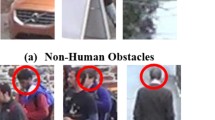Abstract
Person re-identification (ReID) is a challenging task in computer vision area due to the dramatic changes across different non-overlapping camera views, e.g., lighting, view angle, and pose, among which occlusion is one of the hardest challenges. Recently, occluded person re-identification (Occluded-ReID) is proposed to address this problem. Nevertheless, current occluded-ReID methods focus on how to learn a matching function between partial-body images and full-body images while ignore the structural information of the full body. To handle this problem, we propose a novel framework called Mask Guided De-occlusion (MGD) for occluded Person Re-identification. The MGD mainly consists of three components, i.e., a Coarse-to-Fine Mask Generation (CFMG) module, a Person De-Occlusion (PDO) module and a Person Feature Extractor (PFE). The key module CFMG aims to locate the occlusion areas by manipulating the instance segmentation masks through a two-stage process. The proposed PDO module is to reconstruct the occluded pedestrian. After that, all the images are fed into the PFE module to obtain their feature vectors. With PDO and CFMG modules, the proposed method MGD reduces the impact of occlusions and thus improves the performance of Occluded-ReID. The extensive experiments conducted on several public occluded ReID datasets show that our method is effective and outperforms the state-of-the-art methods.
Access this chapter
Tax calculation will be finalised at checkout
Purchases are for personal use only
Similar content being viewed by others
Notes
- 1.
The mask M is a binary matrix of the same size as the original image. \(M(i,j)=1\) represents that the pixel (i, j) is occluded, and \(M(i,j)=0\) represents not occlusion.
References
Chang, X., Hospedales, T.M., Xiang, T.: Multi-level factorisation net for person re-identification. In: CVPR, pp. 2109–2118 (2018)
Chen, K., et al.: MMDetection: Open MMLab detection toolbox and benchmark. arXiv preprint arXiv:1906.07155 (2019)
Feng, Z., Lai, J., Xie, X.: Learning view-specific deep networks for person re-identification. IEEE TIP 27(7), 3472–3483 (2018)
He, L., Liang, J., Li, H., Sun, Z.: Deep spatial feature reconstruction for partial person re-identification: alignment-free approach. In: CVPR, pp. 7073–7082 (2018)
Huang, H., Li, D., Zhang, Z., Chen, X., Huang, K.: Adversarially occluded samples for person re-identification. In: CVPR, pp. 5098–5107 (2018)
Iizuka, S., Simo-Serra, E., Ishikawa, H.: Globally and locally consistent image completion. ACM Trans. Graph. (ToG) 36(4), 107 (2017)
Li, W., Zhu, X., Gong, S.: Harmonious attention network for person re-identification. In: CVPR, pp. 2285–2294 (2018)
Liu, X., et al.: HydraPlus-net: attentive deep features for pedestrian analysis. In: ICCV, pp. 350–359 (2017)
Matsukawa, T., Okabe, T., Suzuki, E., Sato, Y.: Hierarchical Gaussian descriptor for person re-identification. In: CVPR, pp. 1363–1372 (2016)
Pathak, D., Krähenbühl, P., Donahue, J., Darrell, T., Efros, A.: Context encoders: feature learning by inpainting. In: CVPR (2016)
Shen, Y., Lin, W., Yan, J., Xu, M., Wu, J., Wang, J.: Person re-identification with correspondence structure learning. In: ICCV, pp. 3200–3208 (2015)
Su, C., Li, J., Zhang, S., Xing, J., Gao, W., Tian, Q.: Pose-driven deep convolutional model for person re-identification. In: ICCV, pp. 3960–3969 (2017)
Sun, Y., et al.: Perceive where to focus: learning visibility-aware part-level features for partial person re-identification. In: CVPR, June 2019
Sun, Y., Zheng, L., Deng, W., Wang, S.: SVDNet for pedestrian retrieval. In: ICCV, pp. 3800–3808 (2017)
Sun, Y., Zheng, L., Yang, Y., Tian, Q., Wang, S.: Beyond part models: person retrieval with refined part pooling (and a strong convolutional baseline). In: Ferrari, V., Hebert, M., Sminchisescu, C., Weiss, Y. (eds.) ECCV 2018. LNCS, vol. 11208, pp. 501–518. Springer, Cham (2018). https://doi.org/10.1007/978-3-030-01225-0_30
Szegedy, C., Vanhoucke, V., Ioffe, S., Shlens, J., Wojna, Z.: Rethinking the inception architecture for computer vision. In: CVPR, June 2016
Wang, G., Lai, J., Huang, P., Xie, X.: Spatial-temporal person re-identification, pp. 8933–8940 (2019)
Wang, G., Yuan, Y., Chen, X., Li, J., Zhou, X.: Learning discriminative features with multiple granularities for person re-identification. In: ACM MM, pp. 274–282. ACM (2018)
Xiao, T., Li, H., Ouyang, W., Wang, X.: Learning deep feature representations with domain guided dropout for person re-identification. In: CVPR, pp. 1249–1258 (2016)
Yang, C., Lu, X., Lin, Z., Shechtman, E., Wang, O., Li, H.: High-resolution image inpainting using multi-scale neural patch synthesis. In: CVPR, July 2017
Zhang, X., et al.: AlignedReID: surpassing human-level performance in person re-identification. arXiv preprint arXiv:1711.08184 (2017)
Zhao, R., Ouyang, W., Wang, X.: Unsupervised salience learning for person re-identification. In: CVPR, pp. 3586–3593 (2013)
Zheng, C., Cham, T.J., Cai, J.: Pluralistic image completion. arXiv preprint arXiv:1903.04227 (2019)
Zheng, W.S., Li, X., Xiang, T., Liao, S., Lai, J., Gong, S.: Partial person re-identification. In: ICCV, pp. 4678–4686 (2015)
Zheng, Z., Zheng, L., Yang, Y.: Unlabeled samples generated by GAN improve the person re-identification baseline in vitro. In: ICCV (2017)
Zhuo, J., Chen, Z., Lai, J., Wang, G.: Occluded person re-identification. In: ICME, pp. 1–6. IEEE (2018)
Acknowledgments
This project was supported by the NSFC (61573387, U1611461, 61672544).
Author information
Authors and Affiliations
Corresponding author
Editor information
Editors and Affiliations
Rights and permissions
Copyright information
© 2019 Springer Nature Switzerland AG
About this paper
Cite this paper
Zhang, P., Lai, J., Zhang, Q., Xie, X. (2019). MGD: Mask Guided De-occlusion Framework for Occluded Person Re-identification. In: Cui, Z., Pan, J., Zhang, S., Xiao, L., Yang, J. (eds) Intelligence Science and Big Data Engineering. Visual Data Engineering. IScIDE 2019. Lecture Notes in Computer Science(), vol 11935. Springer, Cham. https://doi.org/10.1007/978-3-030-36189-1_34
Download citation
DOI: https://doi.org/10.1007/978-3-030-36189-1_34
Published:
Publisher Name: Springer, Cham
Print ISBN: 978-3-030-36188-4
Online ISBN: 978-3-030-36189-1
eBook Packages: Computer ScienceComputer Science (R0)




